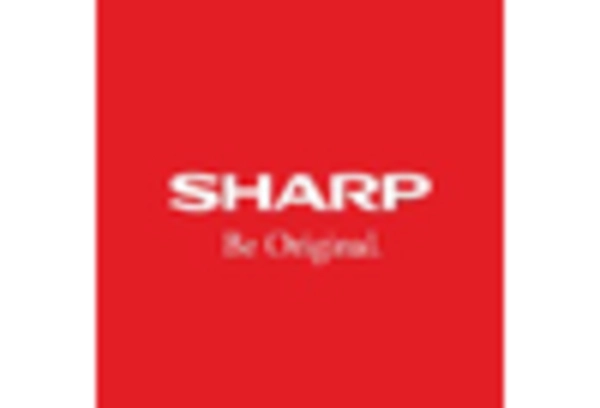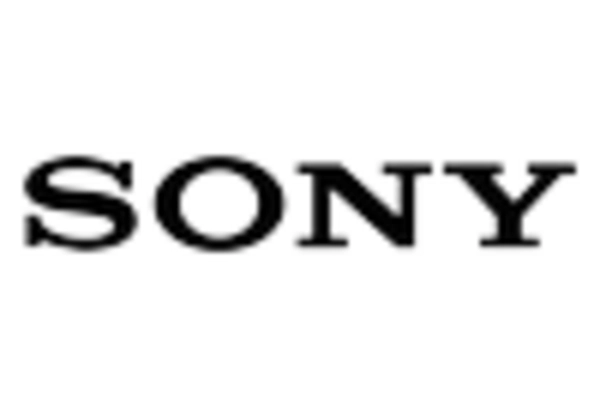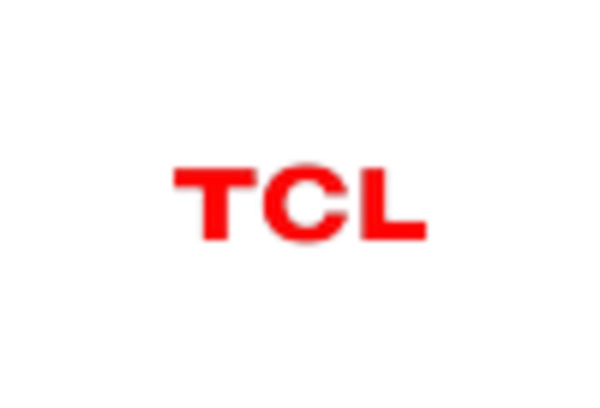Shift Towards Smart Home Devices
The Consumer Electronics Mini LED Market is benefiting from the shift towards smart home devices. As consumers embrace smart technology, the demand for high-quality displays in smart home products is on the rise. Mini LED technology, with its ability to deliver vibrant visuals and energy efficiency, is becoming a preferred choice for manufacturers of smart TVs, smart speakers, and other connected devices. This trend is further supported by the increasing integration of artificial intelligence and IoT capabilities in consumer electronics, which enhances the functionality and appeal of Mini LED displays. The growing market for smart home devices is likely to propel the adoption of Mini LED technology, creating new opportunities for manufacturers.
Competitive Landscape and Market Dynamics
The competitive landscape of the Consumer Electronics Mini LED Market is evolving rapidly. With numerous players entering the market, competition is intensifying, leading to innovations and advancements in Mini LED technology. Companies are investing heavily in research and development to differentiate their products and capture market share. This competitive environment is fostering collaboration between manufacturers and technology providers, resulting in the development of cutting-edge Mini LED solutions. Additionally, the increasing number of partnerships and mergers within the industry is likely to enhance the overall market dynamics, driving growth and expanding the reach of Mini LED technology across various consumer electronics segments.
Rising Demand for Enhanced Visual Quality
The Consumer Electronics Mini LED Market is experiencing a notable surge in demand for enhanced visual quality. As consumers increasingly seek superior display technologies, Mini LED technology offers improved brightness, contrast, and color accuracy compared to traditional LED displays. This demand is particularly pronounced in sectors such as gaming and professional content creation, where visual fidelity is paramount. According to recent data, the market for high-end displays is projected to grow significantly, with Mini LED displays expected to capture a substantial share due to their advanced capabilities. This trend indicates a shift towards premium products, driving manufacturers to innovate and invest in Mini LED technology to meet consumer expectations.
Technological Advancements in Display Technology
Technological advancements play a crucial role in the Consumer Electronics Mini LED Market. Innovations in Mini LED technology, such as improved backlighting techniques and enhanced dimming capabilities, are enabling manufacturers to produce displays that offer better performance and efficiency. These advancements not only enhance the viewing experience but also contribute to the overall energy efficiency of devices. As a result, the market is witnessing a growing interest from manufacturers looking to incorporate Mini LED technology into their product lines. The integration of Mini LED displays in televisions, monitors, and laptops is expected to drive market growth, as consumers increasingly prioritize cutting-edge technology in their purchasing decisions.
Consumer Preference for Energy-Efficient Solutions
Consumer preference for energy-efficient solutions is a significant driver in the Consumer Electronics Mini LED Market. As awareness of environmental issues grows, consumers are increasingly seeking products that minimize energy consumption without compromising performance. Mini LED technology offers a compelling solution, as it provides better energy efficiency compared to traditional LED displays. This shift in consumer behavior is prompting manufacturers to prioritize energy-efficient designs in their product offerings. The market is witnessing a rise in eco-friendly initiatives, with companies focusing on sustainable practices and energy-efficient technologies. This trend is expected to continue, further driving the adoption of Mini LED technology in various consumer electronics.
















Leave a Comment